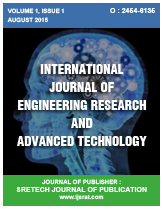Design and Developments of AODV & TAODV Routing Protocols for VANETs
DOI:
https://doi.org/10.31695/IJERAT.2024.1.1Keywords:
VANETs, AODV, TAODV, NS2, Ad_hoc, Routing-protocol, OBU, RSU, RREQ, RREPAbstract
Ad_hoc Vehicle Networks (VANETs) are self-convening networks that are formed between shifting vehicles equipped with wireless transmission devices. This type of network develops within the framework of intelligent transit systems to achieve a significant refinement in the overall performance of the transportation system.
As the foundation regarding that network will increase implementation, challenges have to be taken into account. These challenges are broadcasting, routing, precedence scheduling, safety then privacy. In this research, orientation is viewed as a research factor. Several routing protocols have been introduced and evaluated to restructure the efficiency of VANET. Follow-up research about VANETs has established that the Ad_hoc on-demand distance vector (AODV) has the very best efficiency in structure-based protocols.
The research analyzes and evaluates the performance of AODV under specific node densities. Different sets of node densities are used to compare the overall performance of the mentioned protocol. Then the obtained simulation outcomes are compared among graphic shapes below specific parameters such as delay rate, on the one hand, packet size, packet loss, etc. on the other.
The proposed research suggested the most useful path using the cloned routing protocol via customizing interpretation, simulation, data visualization, and results then comparative evaluation into the current AODV routing protocol and the TAODV cloned routing protocol. The objective of this research is to Unveil the Development and Design of Routing Protocols for VANETs.
The result in this paper of dropped packets affects the AODV protocol during the entire lifetime of the network, but in the case of TAODV, it is only partially affected by the time the malicious node is identified and eliminated. The increased network throughput in the case of using TAODV is attributed to each node using its local table of other nodes' trust values in choosing the next hop node to establish the data path.
In this paper, AODV simulations are performed on simulators with the aid of the used network simulator NS-2 which approves customers to create real-world kinetic models for VANET simulation.
Downloads
Published
Issue
Section
License
Copyright (c) 2024 Intisar Mohsin Saadoon, Maha Ali Hussein, Farah Neamah Abbas

This work is licensed under a Creative Commons Attribution-NonCommercial 4.0 International License.









